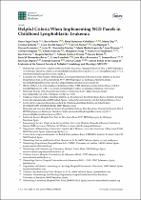Resum
Paraules clau
Leucèmia limfoblàstica aguda infantil; Seqüenciació de nova generació
Citació recomanada
Vega-Garcia N, Benito R, Esperanza-Cebollada E, Llop M, Robledo C, Vicente-Garcés C, et al. Helpful Criteria When Implementing NGS Panels in Childhood Lymphoblastic Leukemia. J Pers Med. 2020 Nov 26;10:244.
Audiència
Professionals
Empreu aquest identificador per citar i/o enllaçar aquest document
https://hdl.handle.net/11351/6353Aquest element apareix a les col·leccions següents
- HVH - Articles científics [2972]
Els següents fitxers sobre la llicència estan associats a aquest element:

